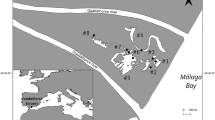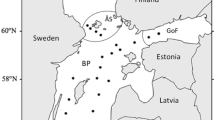Abstract
In situ incubations of natural autotrophic picoplankton populations during a 15 month study were used to test the frequency of dividing cells proceduresin estimating phototrophic picoplankton growth rates. These rates were estimated using dilution experiments and compared to the average frequency of dividing cells over the same time interval. The regression equation of µ = 2.85 × 10−3 (FDC) + 0.022 was calculated to relate autotrophic picoplankton growth rate and the frequency of dividing cells in this study. The resulting relationship was compared to 14C-bicarbonate derived growth rates. Productivity estimates using frequency of dividing cells correlated closely to sodium 14C-bicarbonate results and indicated a range of productivity by autotrophic picoplankton of 55.6% the total phytoplankton primary productivity in July to a January rate of 2.3%. Annual autotrophic picoplankton abundance varied seasonally in the lower Chesapeake Bay ranging from 7.26 × 106 cells 1−1 in winter to 9.28 × 108 cells 1−1 during late summer.
Similar content being viewed by others
References
Affronti, L. F., 1990. Seasonal and diel patterns of abundance and productivity of phototrophic picoplankton in the lower Chesapeake Bay. Doctoral Dissertation, Old Dominion University, Norfolk, Virginia, 141 pp.
Affronti, L. F. & H. G. Marshall, 1990. Picoplankton dynamics in the lower Chesapeake Bay. Assoc. Southeastern Biol. Bull. 37: 69 (Abs.).
Affronti, L. F. & H. G. Marshall, 1993. Diel abundance and productivity patterns of autotrophic picoplankton in the lower Chesapeake Bay. J. Plankton Res. 15: 1–8.
Apstein, C., 1911. Studie über Ceratium tripos var. subsalsa Wiss. Meeresunters. N.F., Bd 12, S. 137–162.
Campbell, L. & E. J. Carpenter, 1986. Diel patterns of cell division in marine Synechococcus spp. (Cyanobacteria): Use of the frequency of dividing cells technique to measure growth rate. Mar. Ecol. Prog. Ser. 32: 139–148.
Christian, R. R., R. B. Hanson & S. Y. Newell, 1982. Comparison of methods for measurement of bacterial growth rates in mixed batch cultures. Appl. envir. Microbiol. 43: 1160–1165.
Davis, P. G. & J. McN. Sieburth, 1984. Estuarine and oceanic microflagellate predation of actively growing bacteria: estimation of frequency of dividing bacteria. Mar. Ecol. Prog. Ser. 19: 237–246.
Fahnenstiel, G. L., T. R. Patton, H. J. Carrick & M. J. McCormick, 1991. Diel division cycle and growth rates of Synechococcus in Lakes Huron and Michigan. Int. Revue ges. Hydrobiol. 76: 657–664.
Fuhram, J. A., J. W. Ammerman & F. Azam, 1980. Bacterioplankton in the coastal euphotic zone: distribution, activity, and possible relationships with phytoplankton. Mar. Biol. 60: 201–207.
Gieskes, W. W., G. W. Kraay & M. A. Baars, 1979. Current 14C methods for measuring primary production: gross under estimates in oceanic waters. Neth. J. Sea Res. 13: 58–78.
Gonzalez, J. M., E. B. Sherr & B. F. Sherr, 1990. Size-selected grazing on bacteria by natural assemblages of estuarine flagellates and ciliates. Appl. envir. Microbiol. 56: 583–589.
Gough, L. H., 1905. Report on the plankton of the English Channel in 1903. Rept. (S. Area) Fishery Hydrogr. Invest. N. Sea 1: 325–327.
Hagström A. J., J. W. Ammerman, S. Henrichs & F. Azam, 1984. Bacterioplankton growth in seawater: II. Organic matter utilization during steady-state growth in seawater cultures. Mar. Ecol. Prog. Ser. 18: 41–48.
Hagström, A. J., U. Larsson, P. Horstedt & S. Normark, 1979. Frequency of dividing cells, a new approach to determination of bacterial growth rates in aquatic environments. Appl. envir. Microbiol. 37: 805–812.
Hanson, R. B., D. Shafer, T. R. Ryan, D. H. Pope & H. K. Lowery, 1983. Bacterioplankton in Antarctic Ocean waters during late Austral winter: abundance, frequency of dividing cells, and estimates of production. Appl. envir. Microbiol. 45: 1622–1632.
Johnson, P. W. & J. McN. Sieburth, 1979. Chroococcoid cyanobacteria in the sea: a ubiquitous and diverse phototropic biomass. Limnol. Oceanogr. 24: 928–935.
Johnson, P. W. & J. McN. Sieburth, 1982. In situ morphology and occurrence of eucaryotic phototrophs of bacterial size in the picoplankton of estuarine and oceanic waters. J. Phycol. 18: 318–327.
Landry, M. R., L. W. Haas & V. L. Fagerness, 1984. Dynamics of microbial plankton communities: experiments in Kaneohe Bay, Hawaii. Mar. Ecol. Prog. Ser. 16: 127–133.
Li, W. K. W., D. V. Subba Roa, W. G. Harrison, J. C. Smith, J. J. Cullen, B. Irwin & T. Platt, 1983. Autotrophic picoplankton in the tropical ocean. Science 219: 292–295.
Li, W. K. W. & P. M. Dickie, 1991. Relationship between the number of dividing and non-dividing cells of cyanobacteria in North Atlantic picoplankton. J. Phycol. 27: 559–565.
Marshall, H. G., 1991. Preliminary results of phytoplankton composition, abundance and distribution in the lower Chesapeake Bay Monitoring Program. Sp. Rpt., Old Dominion University Research Foundation, Norfolk, Va, 61 pp.
McDuff, R. E. & S. W. Chrisholm, 1982. The calculation of in situ growth rates of phytoplankton populations from fractions of cells undergoing mitosis: a clarification. Limnol. Oceanogr. 27: 783–788.
National Oceanic and Atmospheric Administration, 1988. Local climatological data, monthly summary, Norfolk, Va, 4 pp.
National Oceanic and Atmospheric Administration, 1989. Local climatological data, monthly summary, Norfolk, Va, 4 pp.
Newell, S. Y. & R. R. Christian, 1981. Frequency of dividing cells as an estimator of bacterial productivity. Appl. envir. Microbiol. 42: 23–31.
Perkins, F. O., L. W. Haas, D. E. Phillips & K. L. Webb, 1980. Ultrastructure of marine Synechococcus possessing spinae. Can. J. Microbiol. 27: 318–329.
Pick, F. R. & C. Bérubé, 1992. Diel cycles in the frequency of dividing cells of freshwater picocyanobacteria. J. Plankton Res. 14: 1193–1198.
Platt, T. S., S. Roa & B. Irwin, 1983. Photosynthesis of picoplankton in the oligotrophic ocean. Nature 301: 702–704.
Porter, K. G. & Y. S. Feig, 1980. The use of DAPI for identifying and counting aquatic microflora. Limnol. Oceanogr. 25: 943–948.
Ray, R. T., L. H. Haas & M. E. Sieracki, 1989. Autotrophic picoplankton dynamics in a Chesapeake Bay sub-estuary. Mar. Ecol. Prog. Ser. 52: 273–285.
Sieburth, J. McN., V. Smetacek & J. Lenz, 1978. Pelagic ecosystem structure: Heterotrophic compartments of the plankton and their relationship to plankton size. Limnol. Oceanogr. 23: 1256–1263.
Sieracki, M. E., P. W. Johnson & J. McN. Sieburth, 1985. Detection, enumeration, and sizing of planktonic bacteria by image-analyzed epifluorescence microscopy. Appl. envir. Microbiol. 49: 799–810.
Stanier, R. V., E. A. Adelberg, J. L. Ingraham & M. L. Wheelis, 1979. Introduction to the Microbial World. Prentice-Hall, Inc. Englewood Cliffs, N.J., 336 pp.
Strickland, J. D. H. & T. R. Parsons, 1972. A practical handbook of seawater analysis. Bull. 167, Fish. Res. Bd Canada. Ottawa, 310 pp.
Takahashi, M. & P. K. Bienfang, 1983. Size structure of phytoplankton biomass and photosynthesis in subtropical Hawaiian waters. Mar. Biol. 76: 203–211.
Takahashi, M. & T. Hori, 1984. Abundance of picoplankton in the subsurface chlorophyll maximum layer in subtropical and tropical waters. Mar. Biol. 79: 177–186.
Thomsen, H. A., 1986. A survey of the smallest eucaryotic organisms of the marine phytoplankton. In: T. Platt and W. Li (eds), Photosynthetic picoplankton. Can. Bull. Fish. aquat. Sci. 214: 121–158.
Waterbury, J. B., S. W. Watson, R. R. L. Guillard & L. E. Brand, 1979. Wide-spread occurrence of a unicellular marine planktonic cyanobacterium. Nature 277: 293–294.
Waterbury, J. B., S. W. Watson, F. W. Valois & D. G. Franks, 1986. Biological and ecological characterization of the marine unicellular cyanobacterium Synechococcus. In: T. Platt and W. Li (eds), Photosynthetic picoplankton. Can. Bull. Fish. aquat. Sci. 214: 71–120.
Weisse, T., 1988. Autotrophic picoplankton in Lake Constance. J. Plankton Res. 10: 1179–1188.
Author information
Authors and Affiliations
Rights and permissions
About this article
Cite this article
Affronti, L.F., Marshall, H.G. Using frequency of dividing cells in estimating autotrophic picoplankton growth and productivity in the Chesapeake Bay. Hydrobiologia 284, 193–203 (1994). https://doi.org/10.1007/BF00006689
Received:
Revised:
Accepted:
Issue Date:
DOI: https://doi.org/10.1007/BF00006689




